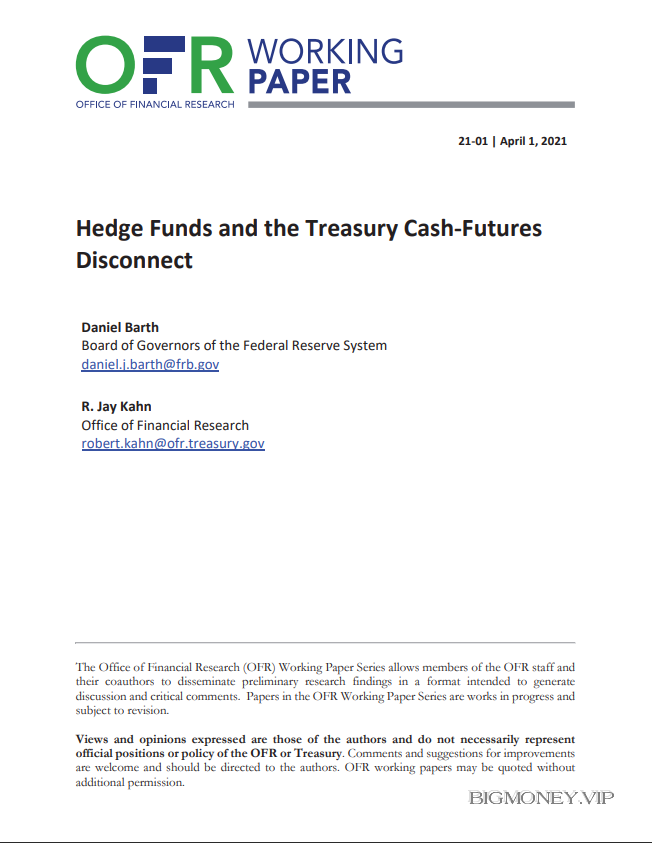Hedge Funds and the Treasury Cash-Futures Disconnect by Daniel Barth and R. Jay Kahn

1 Introduction
During the first week of March 2020, the market for U.S. Treasury securities — the safest and most
liquid asset market in the world — began to experience stress. By March 11, Treasury markets
faced unprecedented disruptions: bid-ask spreads, particularly on longer maturity bonds such as
the 30-year, widened to unseen levels; repurchase agreement (repo) rates on Treasury collateral
skyrocketed; and various arbitrage spreads diverged. It is difficult to overstate the importance of
Treasury markets in the global financial system, and instability there would reverberate to every
corner of financial markets. The Federal Reserve quickly stepped in, dramatically expanding pur-
chases of Treasury securities from dealers and offering unlimited repo and reverse repo facilities
on Treasury collateral.1 By the end of March, turmoil in Treasury markets had largely subsided
and market functioning returned to normal.
The focus soon turned to a post-mortem on how the U.S. Treasury market could have expe-
rienced such severe disruptions. One leading candidate was hedge funds exiting the Treasury
cash-futures “basis trade.”2 The Treasury cash-futures basis represents an arbitrage relationship:
The price of the bond in the cash market (Pt,τ ) must be equal to the present values of the coupon
payments (Bt,scs) plus the futures price (Bt,TFt,τ,T ). When the futures price is too high relative
to the cash price, arbitrageurs can go “long the basis” by buying the cash bond and shorting the
futures. The trade profits from the convergence of the cash and futures prices at the delivery date.
To establish a (nearly) zero net cash outlay, the purchase of the long position is financed in the
repo market, usually short-term or overnight, with the bond as collateral.
In this paper we explore a massive shift in Treasury markets — a dramatic rise in hedge fund
participation. We use a variety of publicly available and regulatory datasets to show that much
of the steep increase in hedge fund Treasury exposure between 2017 to 2019 is attributable to the
cash-futures basis trade, which profits from the disconnect between cash and futures prices. At its
peak, we estimate the size of hedge fund positions associated with the basis trade was between
$400 – $500 billion, constituting more than 60% of total hedge fund Treasury exposure, more than
70% of hedge fund repo borrowing, and more than 25% of dealers’ repo lending.
We argue that through this trade hedge funds serve as warehouses for Treasuries, storing them
on behalf of holders of long Treasury futures positions and funding them in the repo market. This
warehousing role establishes a link between Treasury markets, futures markets, and repo markets.
We show that variability in hedge funds’ costs to warehouse these Treasuries arises from limits to
arbitrage, specifically repo market illiquidity and margin requirements. We construct a model
to illustrate how these limits impair risk-sharing between dealers and holders of long futures
positions. The model also demonstrates that hedge funds’ reliance on market-based financing to
trade the basis potentially exposes the Treasury market to both margin risk and rollover risk on
repo funding. We discuss how many of these risks materialized in March 2020, and rapid and
large-scale Federal Reserve interventions likely prevented a liquidity spiral.
We begin by documenting the disconnect between cash and futures prices. As a simple bench-
mark, we compare the futures price to the present value of the security to be delivered into the
futures contract. In the absence of frictions, the only difference in these prices is due to time;
the cash price is in today’s dollars and the futures price represents dollars at the future delivery
date. We show empirically that for the Treasuries that underlie this trade, as the delivery date
approaches the price of the cash note converges to the futures price, with vanishingly small varia-
tion in the price difference at the delivery date. However, the no-arbitrage condition requires more
than simple convergence; in the absence of financing frictions and inventory costs, the cash note
price must converge to the futures price at the risk-free rate. We show that this condition is fre-
quently violated. Moreover, we show that deviations are extremely persistent, and correlated with
episodes of stress in financial markets, suggesting the importance of limits to arbitrage. We show
that securities that are included in the basis trade have higher average prices than what would
be implied by similar Treasuries. In times of financial stress this spread increases, suggesting the
basis trade contributes to a substantial liquidity premium on the underlying Treasuries.
We next demonstrate that the disconnect in cash and futures prices between 2017 and 2019
was associated with the major shift in Treasury market structure toward hedge funds and market-
Hedge Funds and the Treasury Cash-Futures Disconnect by Daniel Barth and R. Jay Kahn




